

Saint Brendan and His Epic Voyage: Was the Irish Saint the First European in the New World?
- Read Later
Saint Brendan (also referred to by his various epithets ‘the Navigator’, ‘the Voyager’, ‘the Anchorite’, and ‘the Bold’) was an Irish saint who lived between the 5th and 6th centuries AD known for his legendary voyage in search of the ‘Island of Paradise’ or the ‘Land of Promise of the Saints’.
Part of the early Irish monastic tradition, St. Brendan traveled around northwest Europe to preach the Christian faith and to found monasteries. Whilst there is no historical proof available at present to support his famous voyage, the fantastic adventures of the saint were compiled into a piece of literary work known as the ‘ Navigatio Sancti Brendani Abbatis ’ (Voyage of St. Brendan the Abbot).
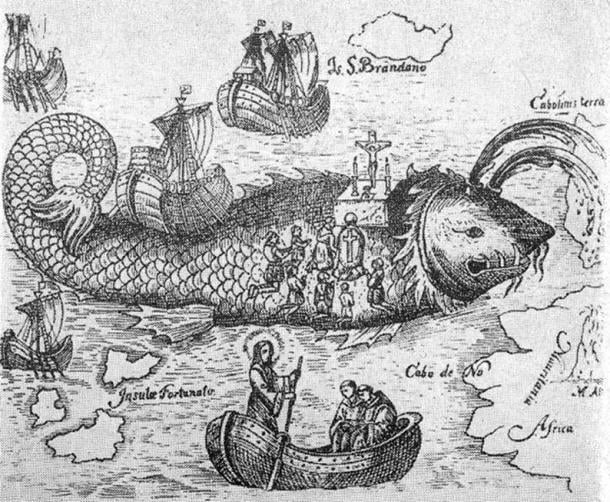
A woodcut which shows the scene from Navigatio Sancti Brendani Abbatis where the saint celebrates a mass on the body of a sea monster. ( Public Domain )
St. Brendan’s Ordination
St. Brendan is recorded to have been born in 484 AD, in Ciarraighe Luachra, near Tralee, a port town in the southwestern Irish county of County Kerry, which is part of the province of Munster. The records also indicate that the future saint was baptized by Saint Erc, another Irish saint, at Tubrid, near Ardfert. After a year with his parents, the child Brendan was sent to the home of a local chieftain, Airde mac Fidaigh at Cathair Airde in Listrim, about 5 km (3.11 miles) to the east of his home. At the end of his fifth year, St. Brendan returned to his family, and continued his studies under Saint Erc. In 510 AD, the saint was ordained a priest by his teacher (another source provides 512 AD as the year in which the saint was ordained).
- True Remains of the Saint Behind the Santa Myth Believed Found in Turkey
- The Immortal Count of Saint Germaine: Ascended Master of Ancient Wisdom
- Viva La Muerte! Santa Muerte, Folk Saint and Holy Personification of Death, Healer and Protector
In the following years, Saint Brendan traveled around the British Isles, spreading Christianity, and founding monastic communities. Some of the monasteries he founded included the ones at Clonfert, in County Galway (which is his largest and most celebrated), at Inis-da-druim (present day Coney Island), in County Clare, and at Shanakeel (known also as Baalynevinoorach), located at the foot of Brandon Hill in County Kerry. Additionally, St. Brendan is also remembered as a voyager thanks to the account of his fantastic voyage in search of the Island of Paradise.
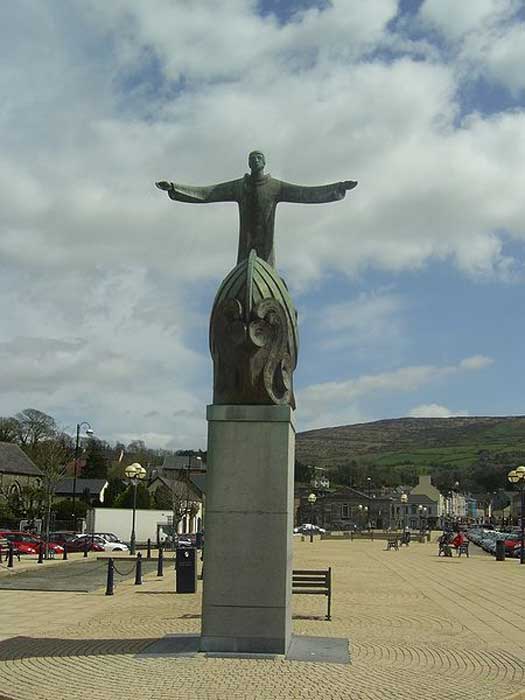
Sculpture of St Brendan, The Square Bantry, County Cork. ( Public Domain )
St. Brendan’s Encounter with a Sea Monster
An account of St. Brendan’s journey to the Island of Paradise may be found in a text known as the ‘ Navigatio Sancti Brendani Abbatis ’, which was written down around the 9th century AD. Several variations are available, which has resulted in some differences in the details of the story. For example, St. Brendan is recorded to have not undertaken the voyage alone, but accompanied by a group of his fellow monks. The number of his companions, however, varies according to the sources, ranging from as few as 14 to as many as 60. In any case, the monks’ voyage took seven years to complete, during which they encountered a number of incredible adventures.
One of these, for example, is the monks’ encounter with the sea monster Jasconius. This tale is said to be the most commonly illustrated adventure of St. Brendan. In the tale, the monks mistake the monster as an island, due to its immense size, and went onto its back. They only realized that their island was in fact a living creature when they made their campfire, as it woke the sea monster up. In one version of the tale, the monks encountered a sea monster that sought to devour them instead. The saint prayed to God for deliverance, and another sea monster emerged from the water to slay the first monster.
- Saint Augustine of Hippo and His Detours on the Long and Winding Path to Christianity
- The Historical Count of Saint-Germaine: Elusive, Enigmatic and Eternal
- When Millions Were Dropping Dead From the Plague, The 14 Holy Helpers Were Summoned to Intercede
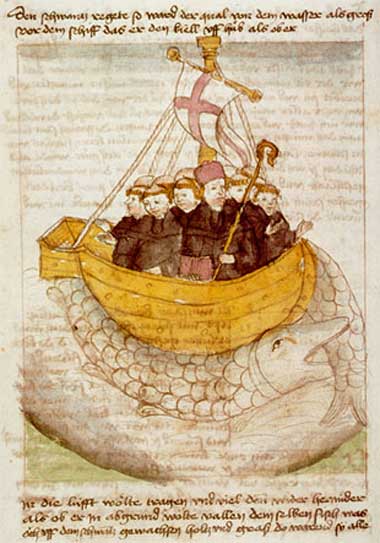
Saint Brendan and the whale from a 15th-century manuscript. ( Public Domain )
Did Saint Brendan Reach the New World?
The voyage of Saint Brendan has led some to argue that it was this Irish saint, rather than the Vikings or Christopher Columbus, who was the first European to have reached the New World. One of the people who sought to determine the veracity of this claim was Tim Severin, a British explorer.
In 1976, Severin built a traditional ship using the design, materials, and techniques that the monks would have used. The explorer successfully sailed from Ireland to North America. Whilst this does not necessarily mean that St. Brendan was the first European to reach the New World, it does demonstrate that the voyage undertaken by the saint was entirely possible.
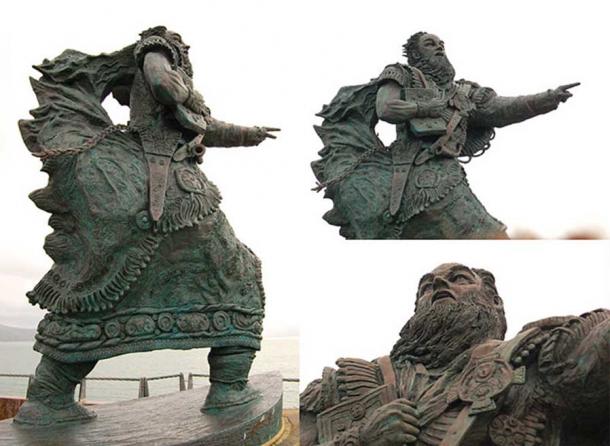
Statue of Brendan at Fenit Harbour. ( CC BY SA 3.0 )
Top image: Exhibit in the Chazen Museum of Art, University of Wisconsin-Madison, Madison, Wisconsin, USA. Source: Public Domain
By Wu Mingren
Anon., The Voyage of St Brendan the Abbot [Online]
[O’Donoghue, D. (trans.) 1893. The Voyage of St Brendan the Abbot .] Available at: http://markjberry.blogs.com/StBrendan.pdf
Grattan-Flood, W. & Hartig, O., 1907. St. Brendan. [Online] Available at: http://www.newadvent.org/cathen/02758c.htm
Haggerty, B., 2011. St. Brendan,The Navigator. [Online] Available at: http://www.irishcultureandcustoms.com/ASaints/BrendanNav.html
Howley, A., 2013. Did St. Brendan Reach North America 500 Years Before the Vikings?. [Online] Available at: https://voices.nationalgeographic.org/2013/05/16/did-st-brendan-reach-north-america-500-years-before-the-vikings/
Newfoundland and Labrador Heritage, 2017. Irish Monks and the Voyage of St. Brendan. [Online] Available at: http://www.heritage.nf.ca/articles/exploration/st-brendan-voyage.php
www.saint-brendan.org , 2010. Saint Brendan The Navigator. [Online] Available at: http://www.saint-brendan.org/index.asp
seems there comes a time when many people so called discovered america even thousands of years ago

Wu Mingren (‘Dhwty’) has a Bachelor of Arts in Ancient History and Archaeology. Although his primary interest is in the ancient civilizations of the Near East, he is also interested in other geographical regions, as well as other time periods.... Read More
Related Articles on Ancient-Origins

St. Brendan the Navigator: The Voyage of the Saint and the Search for the Promised Land
St. Brendan the Navigator, also known as Brendan of Clonfert, is one of the most intriguing figures in the annals of Irish Christianity. Celebrated as a daring seafarer and explorer, he is best known for his legendary voyage in search of the “Promised Land of the Saints.” This article delves into the life of St. Brendan, the tales of his voyages, and the enduring legacy of this adventurous saint.
Early Life and Spiritual Formation
St. Brendan was born around 484 AD in County Kerry, Ireland. He was baptized by St. Erc, a bishop who recognized Brendan’s spiritual potential and provided him with his early education. Brendan was then sent to a monastery school for further education, where he was ordained a priest at the age of 26.
Founding Monasteries
St. Brendan is noted for founding numerous monastic settlements across Ireland. The most famous of these is Clonfert in County Galway, established around 557 AD. These monasteries served as important centers of learning, echoing the Celtic tradition of combining Christian faith with holistic education.
The Voyage of St. Brendan
St. Brendan’s most famous contribution to Irish religious folklore is his legendary voyage across the Atlantic. According to “Navigatio Sancti Brendani Abbatis” (The Voyage of Saint Brendan the Abbot), Brendan was inspired by the story of St. Barinthus, who claimed to have discovered a land of abundance, which Brendan understood to be the “Promised Land of the Saints.”
Intrigued and driven by spiritual curiosity, Brendan decided to undertake a voyage to discover this Promised Land. He reportedly built a curragh, a type of Irish boat with a wooden frame covered in animal hides, and set sail with a group of fellow monks.
Encounters and Miracles
The tales of Brendan’s voyage, which reportedly lasted seven years, are filled with fantastical elements. His journey, as depicted in the Navigatio, included encounters with enormous sea creatures, a floating crystal pillar, an island that turned out to be a sea monster, and a mysterious island inhabited by a hermit.
One of the most captivating stories from Brendan’s voyage is the Easter celebration on the back of a whale. According to the tale, Brendan and his crew, unable to find land during Easter, landed on a small island to hold Mass. As they concluded the service, the island began to move and they realized they had been on the back of a giant sea creature, presumably a whale.
The Land of Promise
The climax of St. Brendan’s voyage was the discovery of the Land of Promise. This land, as described in the Navigatio, was a paradise filled with lush vegetation, abundant flowers, and rich fruits. After spending forty days exploring this land, an angel appeared to Brendan and told him to return to Ireland. The angel informed Brendan that the Land of Promise would remain hidden until the end of time.
Return to Ireland
Following his epic voyage, St. Brendan returned to Ireland where he continued his ecclesiastical work. His accounts of the voyage spread far and wide, inspiring numerous manuscripts and adaptations.
Death and Sainthood
St. Brendan died in 577 AD at the monastery of Annaghdown while visiting his sister Briga. He was buried in Clonfert, and his tomb soon became a pilgrimage site. Although there are no records of his formal canonization, his sainthood was widely recognized by local Christian communities, and he was venerated as the patron saint of sailors and travelers.
Impact and Influence of the Voyage
St. Brendan’s legendary journey ignited the imagination of many explorers in the centuries that followed. The detailed descriptions of his voyage were used as a navigational guide in the Middle Ages, inspiring a belief in a land beyond the known world.
The belief in St. Brendan’s Island, an island supposedly discovered by Brendan during his voyage, persisted on maps until the 19th century. Some have even proposed that Brendan reached the Americas long before Columbus, although this theory is a subject of ongoing debate.
St. Brendan in Art and Literature
The tales of St. Brendan’s voyage have had a lasting influence on art and literature. He has often been depicted in a boat or holding an oar, symbolizing his seafaring adventures. In literature, his voyage has been the subject of numerous adaptations, including novels, poems, and plays.
One of the most famous literary works based on Brendan’s journey is the Latin poem “Navigatio Sancti Brendani,” which dates back to at least the 9th century. This poem has been translated into many languages and has inspired countless retellings.
Modern Celebrations and Veneration
St. Brendan’s feast day is celebrated on May 16th, and he is venerated as the patron saint of sailors, mariners, and travelers. In many coastal communities in Ireland and elsewhere, St. Brendan’s Day is marked with processions and special church services. In addition, many seafaring traditions and customs are associated with St. Brendan, highlighting his enduring influence on maritime culture.
St. Brendan’s Legacy
While the historical accuracy of St. Brendan’s voyage is a subject of debate, its influence on Christian tradition and folklore is undeniable. The stories of his journey continue to captivate the imagination, symbolizing the human quest for spiritual discovery and exploration.
St. Brendan’s life and journey embody the spirit of adventure inherent in the Christian quest for spiritual truth. His voyage represents the journey of the soul towards the divine, navigating through the unknown in search of the Promised Land.
St. Brendan and the Christian Imagination
The tale of St. Brendan’s voyage continues to hold a unique place in the Christian imagination. It combines elements of adventure, faith, and the miraculous, providing a rich narrative that has been retold and reimagined across the centuries.
From a broader perspective, St. Brendan’s voyage can be viewed as a metaphor for the Christian journey through life. Just as Brendan navigated through uncharted waters, facing both peril and wonder, so too does the Christian navigate through the trials and joys of life, guided by faith towards the ultimate Promised Land.
St. Brendan and Irish Cultural Identity
St. Brendan is not only a significant figure in Christian history, but he also holds a special place in Irish cultural identity. His story ties together elements of monastic spirituality, a deep connection with nature, and a spirit of exploration and adventure. As such, St. Brendan embodies many of the qualities and values that are central to Irish cultural identity.
In conclusion, St. Brendan the Navigator remains one of the most fascinating figures in Irish Christian history. His legendary voyage continues to inspire, reminding us of the power of faith, the allure of the unknown, and the limitless possibilities of the human spirit.
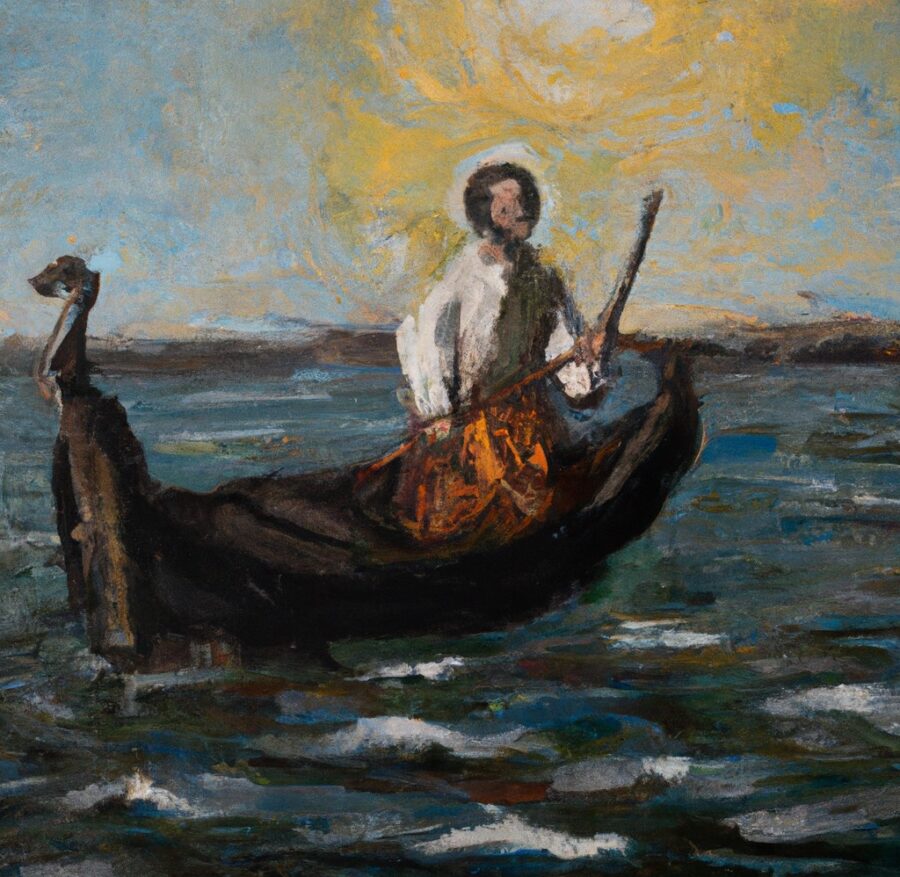
Did you find this helpful?
Related posts.
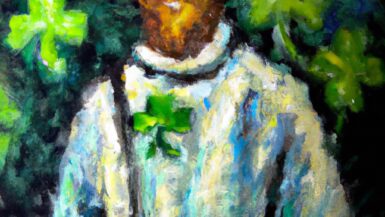
St. Patrick: The Patron Saint of Ireland and His Legendary Exploits
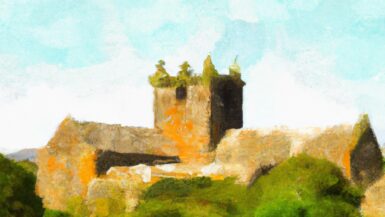
St. Columba: The Irish Saint Who Battled a Monster and Converted Scotland
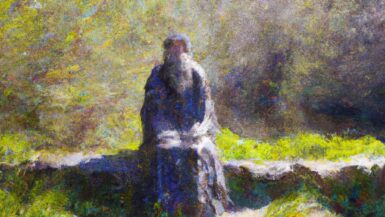
St. Kevin of Glendalough: A Hermit’s Life, Miracles, and the Blackbird’s Nest
Leave a reply cancel reply.
Your email address will not be published. Required fields are marked *
Save my name, email, and website in this browser for the next time I comment.
- 4711ers forum
Sign up to our Newsletter to receive updates on Gigs, Christy Chat and any Christy News
- Christy Chat
- Bookings & Enquiries
- Discography
St. Brendan’s Voyage
Tuesday, May 29th, 2012
Christy Moore
A boat sailed out of Brandon in the year of 501 ’twas a damp and dirty mornin’ Brendan’s voyage it began. Tired of thinnin’ turnips and cuttin’ curley kale When he got back from the creamery he hoisted up the sail. He ploughed a lonely furrow to the north, south, east and west Of all the navigators, St. Brendan was the best. When he ran out of candles he was forced to make a stop, He tied up in Long Island and put America on the map. Did you know that Honolulu was found by a Kerryman, Who went on to find Australia then China and Japan. When he was touchin’ 70, he began to miss the crack, Turnin’ to his albatross he sez “I’m headin’ back”.
To make it fast he bent the mast and built up mighty steam. Around Terra del Fuego and up the warm Gulf Stream, He crossed the last horizon, Mt. Brandon came in sight And when he cleared the customs into Dingle for the night. When he got the Cordon Bleu he went to douse the drought, He headed west to Kruger’s* to murder pints of stout Around by Ballyferriter and up the Conor Pass He freewheeled into Brandon, the saint was home at last.
The entire population came (281) the place was chock-a-block Love nor money wouldn’t get your nose inside the shop. The fishermen hauled up their nets, the farmers left their hay, Kerry people know that saints don’t turn up every day. Everythin’ was goin’ great ’til Brendan did announce His reason for returnin’ was to try and set up house. The girls were flabbergasted at St. Bredan’s neck To seek a wife so late in life and him a total wreck.
Worn down by rejection that pierced his humble pride, “Begod”, sez Brendan “If I run I’ll surely catch the tide” Turnin’ on his sandals he made straight for the docks And haulin’ up his anchor he cast off from the rocks. As he sailed past Inishvickallaun there stood the albatross “I knew you’d never stick it out, ’tis great to see you boss” “I’m bailin’ out” sez Brendan, “I badly need a break A fortnight is about as much as any aul saint could take.”
“Is it right or left for Gibraltar” “What tack do I take for Mizen Head?” “I’d love to settle down near Ventry Harbour”, St. Brendan to his albatross he said.
* – Kruger Kavanagh’s, the ‘Nearest pub to the States’
The Brendan Voyage
- Post author By Simon King
- Post date July 24, 2020
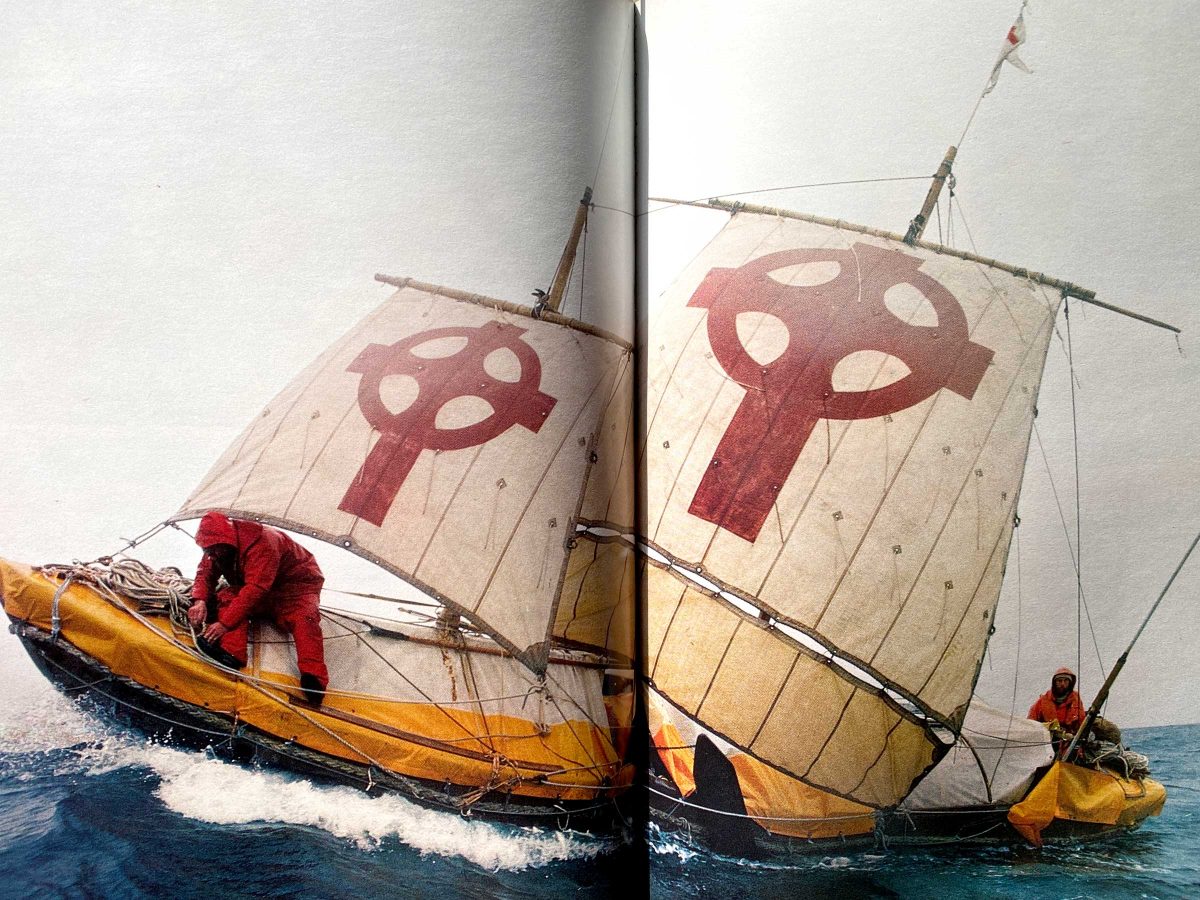
You could say that Tim Severin is a historical re-enactor, but that would conjure all the wrong images, of renaissance fairs and Colonial Williamsburg. At nearly 80 years old, his accomplishments are better described as experiential archaeology , recreating legendary journeys to prove they could have happened. His historical adventures are based on years of upfront study, working with scholars to decipher ancient texts and find period-appropriate technology and materials. I only recently learned about Severin’s work, through his 1978 book that documents a fascinating early project called The Brendan Voyage .
In the 6th-century, an Irish monk named St. Brendan wrote the Navigatio Sancti Brendani Abbatis (The Voyage of St. Brendan the Abbot), a document describing a westward sea journey to the “promised land” that some believe was North America. The journey included numerous stops at islands along the way, and he described seeing fantastic sights and creatures from aboard his medieval “skin boat.” Although some scholars interpret the monk’s manuscript figuratively, others subscribe to the belief that it is more travelogue than fable. That question is at the heart of The Brendan Voyage , Severin’s project to recreate St. Brendan’s journey and prove that a leather-clad sailboat could successfully traverse the North Atlantic.
“Of course, if the claim was true, then Saint Brendan would have reached America almost a thousand years before Columbus and four hundred years before the Vikings.” The Brendan Voyage by Tim Severin, Chapter 1
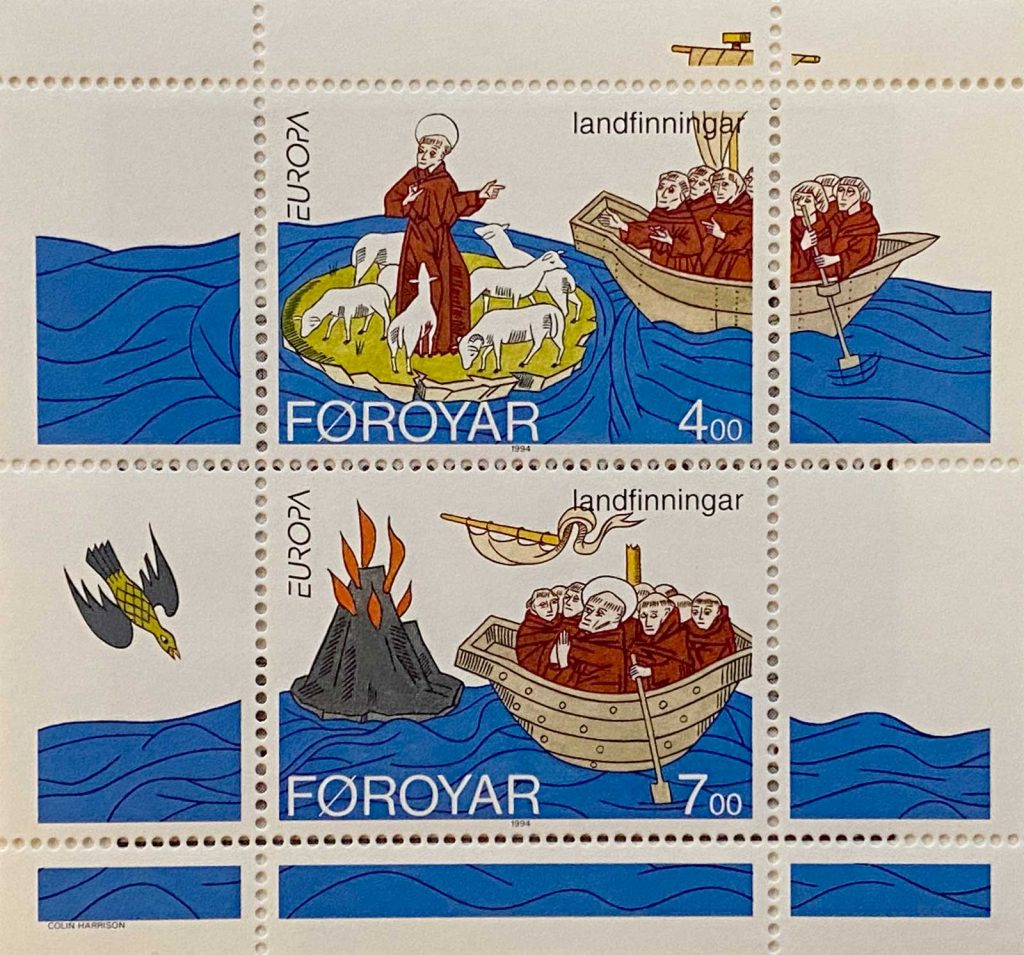
Severin’s first task, which took years of hard work, was the creation of a boat that would match the one used by St. Brendan. In The Brendan Voyage he describes a process of researching, learning, and collaborating with various experts. The energy surrounding the project is contagious, and propelled by what he calls “Brendan Luck” that seems to grace him throughout the project.
The traditional Irish curragh , which is still in use today on the west coast of Ireland, is a descendent of the boat that St. Brendan would have sailed. In modern times, canvas is stretched over the wooden frame, but the Navigatio describes a boat covered with oxhide. This was the first materials challenge for Severin, and initial tests showed that leather would deteriorate quickly in sea water.
Luckily the text provides additional clues, describing the leather as “tanned in oak bark” and coated in “grease” to make it water proof. After numerous lab studies it was proven that, indeed, oak bark was the best leather treatment. Severin found a single tannery in Britain that could help, run by the Croggon family in the Cornish town of Grampound. They had been using traditional tanning techniques since they opened in 1711, and as Brendan Luck would have it, they were enthusiastic about the project.
“So began a delightful period of work. The British leather industry took the Brendan project to heart, and what splendid people the leathermakers turned out to be.” The Brendan Voyage by Tim Severin, Chapter 2
The manuscript describes applying “grease” to the leather, and even mentions bringing extra grease on the journey for re-application. These kinds of details further convinced Severin that he was reading the documentation of a real trip. It’s easy to determine that this must have been lanolin or “wool grease,” a wax that secreted by sheep. Severin and his crew applied it liberally to the oak bark leather and described the resulting stench as nearly unbearable.
“I wonder if you could supply me with some wool grease.” “Yes, of course. How much do you want?” “About three-quarters of a ton, please.” There was stunned silence. The Brendan Voyage by Tim Severin, Chapter 2
The remaining challenges of building Brenden , a 36-foot medieval boat were numerous and back breaking. Just the right cuts of oak and ash were found to build the mast and hull—apparently the north side of the tree is the strongest. Joints were lashed together with miles of leather stripping, and 49 overlapping ox hides were stitched together with flax cords. Brendan Luck struck again when Severin learned that John O’Connell, a master harness maker, lived nearby where the boat was being built. He joined the project and taught Severin and a team of volunteers how to stitch the thick leather. Once on the ocean their lives would depend on the quality of every stitch and knot, a reality that hung heavy over the slow and strenuous work.
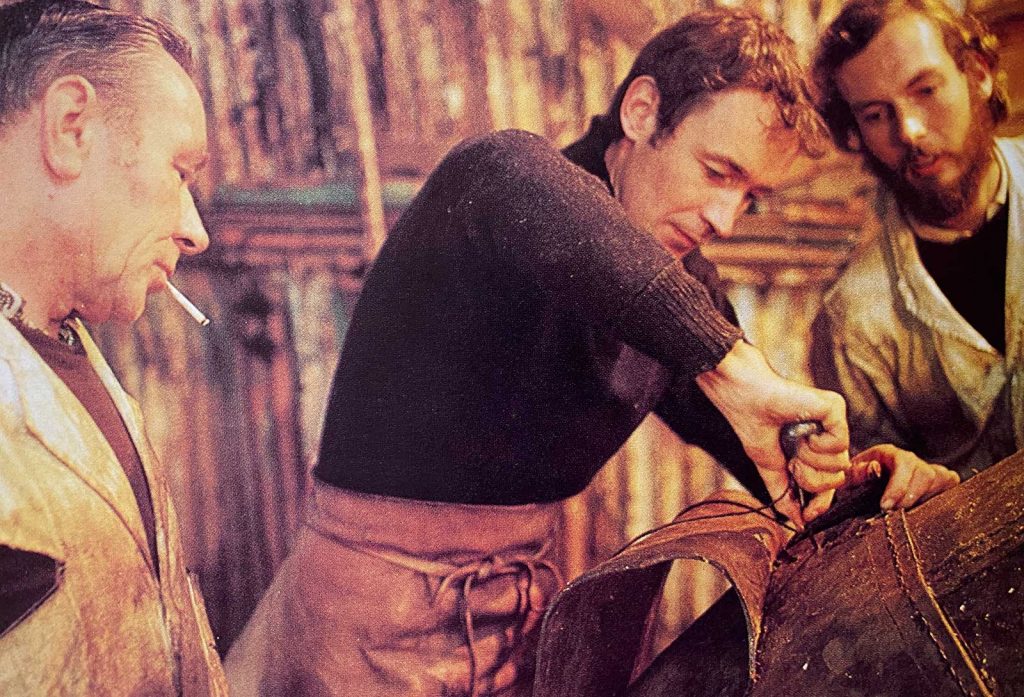
For more detail on the boat’s construction I suggest checking out the article Across the Atlantic in a Leather Boat , which includes relevant excepts from the book and broader information on traditional skin boats in other parts of the world.
The Journey
On May 17, 1976 Brenden set sail from Brandon Creek (named after an alternate spelling of the monk’s name) in County Kerry, Ireland. Every step of the voyage is detailed wonderfully in the book, including photographs from aboard the boat. Even though I knew they would make it, the vivid description of life aboard the boat was both nail biting and riveting.
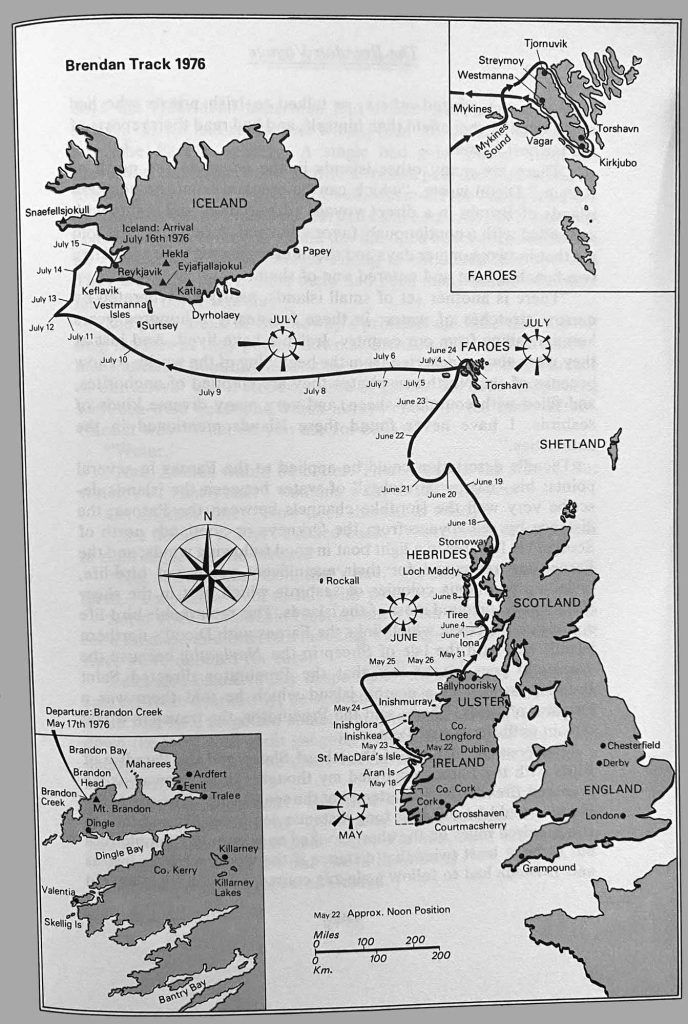
The route, as with the boat’s construction, was an attempt to recreate the original journey as much as possible. Brendan followed a “stepping stone” path along the western coast of Ireland, and into the Outer Hebrides of Scotland. The first long stretch at sea was from Stornoway to the Faroe Islands, and in-between the crew was delighted by continual visits from pods of curious whales.
The Faroes are a potential match for two of the islands mentioned in the Navigatio : “The Island of Sheep” and “The Paradise of Birds.” As they approached the islands from the west, a storm in the Mykines Sound nearly forced Brendan to sail onward without landing, but they managed to maneuver north around Streymoy and land safely in the harbor at Tjørnuvík.
“More than any other people I had ever met, the Faroese understood the sea and showed their appreciation of the endeavor, and once again it was easy to detect the common bond which linked all seafarers in those hostile, northern waters.” The Brendan Voyage by Tim Severin, Chapter 7
Throughout the journey, there were a few points where it became necessary for crew members to leave the project, because of injury or circumstance, and thus new people were needed to join. On the Faroe Islands, Brendan Luck would have it, that Tim Severin met Tróndur Patterson.
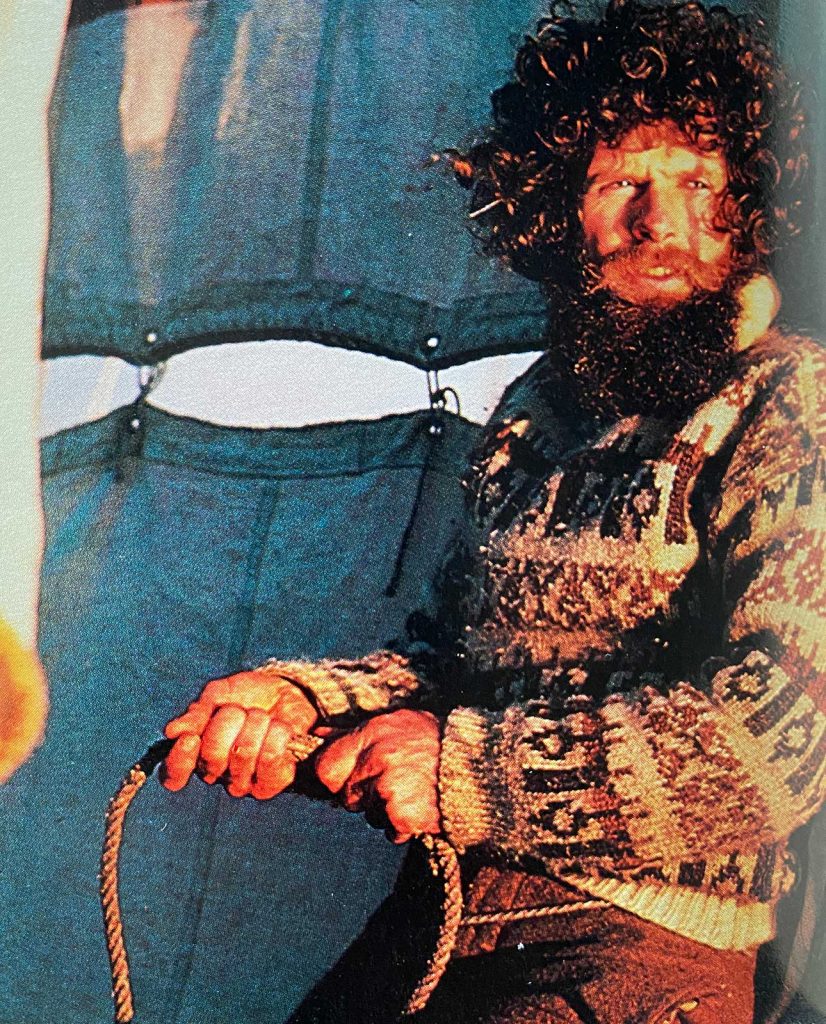
Today, Tróndur Patterson is a well known artist in the Faroe Islands. He’s celebrated for his paintings, sculptures, and glass art that are inspired by life at sea. Severin described meeting Tróndur as an almost fateful occurrence, beginning with an invitation to his home in Kirkjubøur where he realized that the village had a historical place name related to St. Brendan.
“What is the name of the village?” I asked. “Kirkjubo,” she replied. “Does it have any other name?” “Yes, sometimes this place is called Brandarsvik.” The Brendan Voyage by Tim Severin, Chapter 7
Tróndur was quieter than the other crew members, but he brought a Faroese confidence to life at sea. He was adept at catching seabirds using whale blubber, and had tricks for staying warm in soaking wet clothes. He also had a sixth sense for a how to respond in stormy weather, which proved invaluable during the latter half of the trip. His spare time at sea was spent drawing, and the book is filled with his illustrations.
Not only was Patursson a vital crew member on Brendan , the fateful meeting kicked off a longer collaboration with Severin. Just two years after The Brendan Voyage was complete they were reunited aboard another ancient vessel to attempt The Sindbad Voyage .
From the Faroe Islands the crew sailed to Iceland, which St. Brendan called the “Island of Smiths” in an apparent description of a volcanic eruption. After bringing the boat ashore in Reykjavík, it was clear that Brendan had fared well. The leather hull was coated in barnacles, but without a single tear or hole. Still, after weeks of waiting for favorable weather, it was determined that the sea between Iceland and Greenland was simply too rough to continue; sailing season was over. They decided to wait until the following spring and docked Brendan in Iceland for the winter.
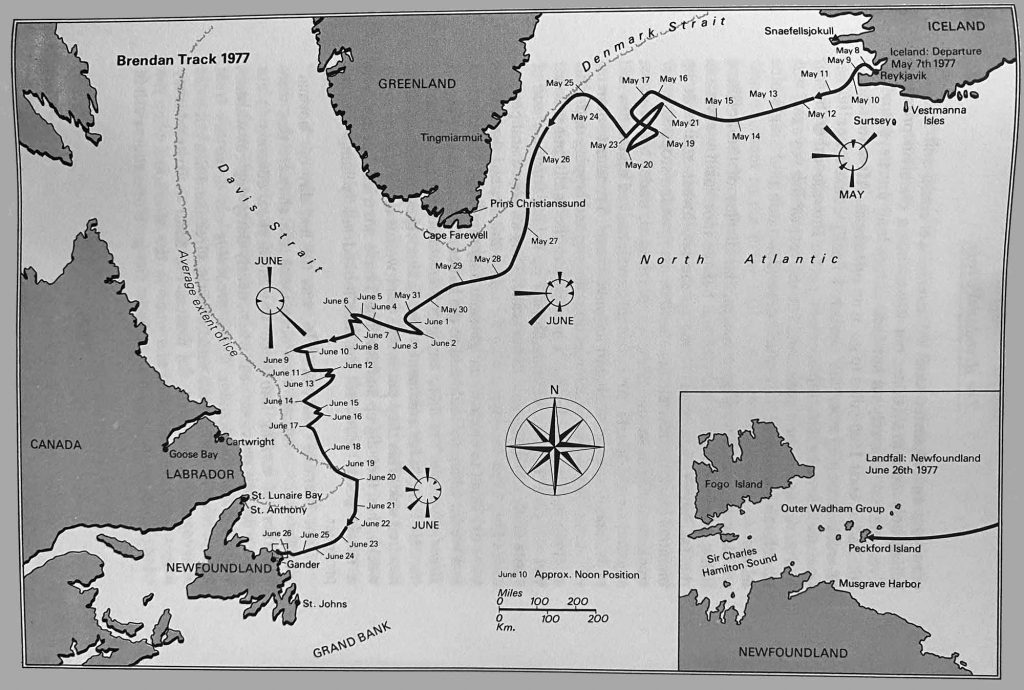
It had always been a good guess that the last leg of the trip would be the hardest, since the waters around Greenland and Labrador are sparsely inhabited and treacherous. That turned out to be true for Brendan , which nearly capsized in stormy weather and suffered damage to her leather hull while navigating through icebergs. It was touch and go at times, but of course, in the end, they were successful. On June 26, 1977 the voyage was completed by landing on Peckford Island, Newfoundland. In the documentary , which includes film from land-based crews as well as onboard footage, we see excited crowds awaiting the boat’s arrival and an impromptu parade celebrating the sailors’ accomplishment.
A successful voyage of course doesn’t prove that Irish monks came to North America a thousand years before Columbus, but it does show that they could have using the technology available to them. I find The Brendan Voyage fascinating for both its historical significance and the way it transpires across so many of my favorite islands. I’m also impressed by how well documented it was, the detail of the book and accompanying film. I’m surprised I hadn’t heard about this adventure before, given that it concluded a full year before I was born. I guess I should consider it Brendan Luck that it finally crossed my path.
I’d suggest getting a physical copy of the The Brendan Voyage book , perhaps seeking out the original 1978 hardcover to ensure it has all of the photographs, maps, and illustrations by Tróndur Patursson.
Whether you read it or not, I highly recommend watching the documentary, which is available on YouTube in two parts and is just under an hour in total.
Finally, you might be interested in this Story Map about The Brendan Voyage , which includes accurate Google Maps showing the route across the North Atlantic.
- Tags boat , faroe islands , greenland , history , iceland , ireland , newfoundland , scotland
St. Brendan
Please help support the mission of New Advent and get the full contents of this website as an instant download. Includes the Catholic Encyclopedia, Church Fathers, Summa, Bible and more — all for only $19.99...
St. Brendan of Ardfert and Clonfert , known also as Brendan the Voyager, was born in Ciarraighe Luachra, near the present city of Tralee, County Kerry, Ireland , in 484; he died at Enachduin, now Annaghdown, in 577. He was baptized at Tubrid, near Ardfert, by Bishop Erc. For five years he was educated under St. Ita , "the Brigid of Munster", and he completed his studies under St. Erc, who ordained him priest in 512. Between the years 512 and 530 St. Brendan built monastic cells at Ardfert, and at Shanakeel or Baalynevinoorach, at the foot of Brandon Hill. It was from here that he set out on his famous voyage for the Land of Delight. The old Irish Calendars assigned a special feast for the "Egressio familiae S. Brendani", on 22 March; and St Aengus the Culdee, in his Litany, at the close of the eighth century, invokes "the sixty who accompanied St. Brendan in his quest of the Land of Promise". Naturally, the story of the seven years' voyage was carried about, and, soon, crowds of pilgrims and students flocked to Ardfert. Thus, in a few years, many religious houses were formed at Gallerus, Kilmalchedor, Brandon Hill, and the Blasquet Islands, in order to meet the wants of those who came for spiritual guidance to St. Brendan.
Having established the See of Ardfert, St. Brendan proceeded to Thomond, and founded a monastery at Inis-da-druim (now Coney Island, County Clare), in the present parish of Killadysert, about the year 550. He then journeyed to Wales , and thence to Iona , and left traces of his apostolic zeal at Kilbrandon (near Oban) and Kilbrennan Sound. After a three years' mission in Britain he returned to Ireland , and did much good work in various parts of Leinster, especially at Dysart (Co. Kilkenny), Killiney (Tubberboe), and Brandon Hill. He founded the Sees of Ardfert, and of Annaghdown, and established churches at Inchiquin, County Galway , and at Inishglora, County Mayo. His most celebrated foundation was Clonfert , in 557, over which he appointed St. Moinenn as Prior and Head Master. St. Brendan was interred in Clonfert , and his feast is kept on 16 May.
Voyage of St. Brendan
St. Brendan belongs to that glorious period in the history of Ireland when the island in the first glow of its conversion to Christianity sent forth its earliest messengers of the Faith to the continent and to the regions of the sea. It is, therefore, perhaps possible that the legends , current in the ninth and committed to writing in the eleventh century, have for foundation an actual sea-voyage the destination of which cannot however be determined. These adventures were called the "Navigatio Brendani", the Voyage or Wandering of St. Brendan, but there is no historical proof of this journey. Brendan is said to have sailed in search of a fabled Paradise with a company of monks , the number of which is variously stated as from 18 to 150. After a long voyage of seven years they reached the "Terra Repromissionis", or Paradise , a most beautiful land with luxuriant vegetation. The narrative offers a wide range for the interpretation of the geographical position of this land and with it of the scene of the legend of St. Brendan. On the Catalonian chart (1375) it is placed not very far west of the southern part of Ireland . On other charts, however, it is identified with the "Fortunate Isles" of the ancients and is placed towards the south. Thus it is put among the Canary Islands on the Herford chart of the world (beginning of the fourteenth century); it is substituted for the island of Madeira on the chart of the Pizzigani (1367), on the Weimar chart (1424), and on the chart of Beccario (1435). As the increase in knowledge of this region proved the former belief to be false the island was pushed further out into the ocean. It is found 60 degrees west of the first meridian and very near the equator on Martin Behaim's globe. The inhabitants of Ferro, Gomera, Madeira, and the Azores positively declared to Columbus that they had often seen the island and continued to make the assertion up to a far later period. At the end of the sixteenth century the failure to find the island led the cartographers Apianus and Ortelius to place it once more in the ocean west of Ireland ; finally, in the early part of the nineteenth century belief in the existence of the island was completely abandoned. But soon a new theory arose, maintained by those scholars who claim for the Irish the glory of discovering America, namely, MacCarthy, Rafn, Beamish, O'Hanlon , Beauvois, Gafarel, etc. They rest this claim on the account of the Northmen who found a region south of Vinland and the Chesapeake Bay called "Hvitramamaland" (Land of the White Men) or "Irland ed mikla" (Greater Ireland ), and on the tradition of the Shawano (Shawnee) Indians that in earlier times Florida was inhabited by a white tribe which had iron implements. In regard to Brendan himself the point is made that he could only have gained a knowledge of foreign animals and plants, such as are described in the legend, by visiting the western continent. On the other hand, doubt was very early expressed as to the value of the narrative for the history of discovery. Honorius of Augsburg declared that the island had vanished; Vincent of Beauvais denied the authenticity of the entire pilgrimage , and the Bollandists do not recognize it. Among the geographers, Alexander von Humboldt, Peschel, Ruge, and Kretschmer, place the story among geographical legends, which are of interest for the history of civilization but which can lay no claim to serious consideration from the point of view of geography. The oldest account of the legend is in Latin, "Navigatio Sancti Brendani", and belongs to the tenth or eleventh century; the first French translation dates from 1125; since the thirteenth century the legend has appeared in the literatures of the Netherlands , Germany , and England . A list of the numerous manuscripts is given by Hardy, "Descriptive Catalogue of Materials Relating to the History of Great Britain and Ireland" (London, 1862), I, 159 sqq. Editions have been issued by : Jubinal, "La Legende latine de S. Brandaines avec une traduction inedite en prose et en poésie romanes" (Paris, 1836); Wright, "St. Brandan, a Medieval Legend of the Sea, in English Verse, and Prose" (London, 1844); C. Schroder, "Sanct Brandan, ein latinischer und drei deutsche Texte" (Erlangen, 1871); Brill, "Van Sinte Brandane" (Gronningen, 1871); Francisque Michel, Les Voyages merveilleux de Saint Brandan a la recherche du paradis terrestre" (Paris, 1878); Fr. Novati, "La Navigatio Sancti Brandani in antico Veneziano" (Bergamo, 1892); E. Bonebakker, "Van Sente Brandane" (Amsterdam, 1894); Carl Wahland gives a list of the rich literature on the subject and the old French prose translation of Brendan's voyage (Upsala, 1900), XXXVI-XC.
Beamish, The Discovery of America (1881), 210-211; O'Hanlon, Lives of the Irish Saints (Dublin, 1875), V, 389; Peschel, Abhandlungen zur Erd- und Volkerkunde (Leipzig, 1877), I, 20-28; Gaffarel, Les Votages de Saint Brandan et des Papœ dans l'Atlantique au moyen age in Bulletin de la Societé de Géographie de Rochefort (1880-1881), II, 5; Ruge, Geschichte des Zeitalters der Entdeckungen (Leipzig, 1881); Schirmer, Zur Brendanus Legende (Leipzig, 1888); Zimmer, Keltische Beiträge in Zeitschrift für deutsches Altertum und deutsche Litteratur (1888-89), 33; Idem, Die frühesten Berührungen der Iren mit den Nordgermanen in Berichte der Akademie der Wissenschaft (Berlin, 1891); Kretschmer, Die Entdeckung Amerikas (Berlin, 1892, Calmund, 1902), 186-195; Brittain, The History of North America (Philadelphia, 1907), I, 10; Rafn, Ant. Amer. , XXXVII, and 447-450; Avezac, Les Iles fantastiques de l'océan occidental in Nouv. An. des voyages et de science geogr. , (1845), I, 293; MacCarthy, The voyage of St. Brendan , in Dublin University Magazine (Jan. 1848), 89 sqq.
About this page
APA citation. Grattan-Flood, W., & Hartig, O. (1907). St. Brendan. In The Catholic Encyclopedia. New York: Robert Appleton Company. http://www.newadvent.org/cathen/02758c.htm
MLA citation. Grattan-Flood, William, and Otto Hartig. "St. Brendan." The Catholic Encyclopedia. Vol. 2. New York: Robert Appleton Company, 1907. <http://www.newadvent.org/cathen/02758c.htm>.
Transcription. This article was transcribed for New Advent by Kieran O'Shea.
Ecclesiastical approbation. Nihil Obstat. 1907. Remy Lafort, S.T.D., Censor. Imprimatur. +John M. Farley, Archbishop of New York.
Contact information. The editor of New Advent is Kevin Knight. My email address is webmaster at newadvent.org. Regrettably, I can't reply to every letter, but I greatly appreciate your feedback — especially notifications about typographical errors and inappropriate ads.
CONTACT US | ADVERTISE WITH NEW ADVENT
St Brendan The Navigator

St Brendan of Clonfert or in Irish; Naomh Breandán, is known as "the Navigator", "the Voyager", or "the Bold" and is one of the early Irish monastic saints and was one of the Twelve Apostles of Ireland .
He is chiefly renowned for his legendary quest to the "Isle of the Blessed," also called St. Brendan's Island which is known as the Voyage of St. Brendan.
Saint Brendan's feast day is celebrated on May 16th in the Eastern Orthodox Church, Roman Catholic Church and within the Anglican Communion.
St Brendan's early life
He was baptized at Tubrid, near Ardfert, by Saint Erc. For five years he was educated under the care Saint Ita, who is known as "the Brigid of Munster", and he then went on to complete his studies under Saint Erc, who ordained him as a priest in the year 512.
Between the years 512 and 530 St Brendan built monastic sites at Ardfert at the foot of Mount Brandon. After these years he is supposed to have set out on his famous seven-year voyage for Paradise.
The old Irish Calendars assigned a special feast for the "Egressio familiae S. Brendani", on March 22nd; and St Aengus the Culdee, in his Litany composed at the close of the eighth century, called upon "the sixty who accompanied St. Brendan in his quest for the Land of Promise".
The Voyage of St Brendan the Navigator
Many versions of this story exist, passed down through the centuries, which tell of how he set out onto the Atlantic Ocean with sixty pilgrims, however, some other versions have fourteen pilgrims, plus three unbelievers who join at the last minute. The purpose of their voyage was to search for the Garden of Eden.
One of these companions is said to have been Saint Malo.
If the voyage did take place, it would have occurred sometime between 512-530 AD, before Brendan traveled to the island of Great Britain.
He is said to have also encountered a sea monster, an adventure he shared with his contemporary St. Columba . This most commonly illustrated adventure is his landing on an island which turns out to be a giant sea monster called Jasconius or Jascon. This too, has its parallels in other stories, not only in Irish mythology but in other traditions, from Sinbad the Sailor to Pinocchio.
Later life of St Brendan
Later in his life, Brendan traveled to Wales and the holy island of Iona, where St Columba spent his exile from Ireland. It is situated off the west coast of Scotland.
On returning to Ireland, he founded a monastery at Annaghdown, where he spent the rest of his days.
St Brendan's Legacy
Saint Brendan is featured as well known inspiration in popular culture also, such as; "The Brendan Voyage", which is an orchestral suite for the Uilleann pipes , written by Irish composer Shaun Davey in 1983 and based on Tim Severin's book of the same name.
Novelist Frederick Buechner retold the story of Brendan's travels in his 1987 novel, "Brendan".
The Celtic band, "Iona", made an entire recording inspired by the voyage of Saint Brendan called, "Beyond These Shores", now available as part of the recording, "The River Flows".
Singer-songwriter, Sarana Verlin, wrote an instrumental song titled, "St. Brendan's Reel", that appears on several albums including, "Amadon Crest".
In the 2005 film, "Beowulf & Grendel", a traveling monk named Brendan the Celt sails to Denmark circa 521 A.D.
The cream liqueur "Saint Brendan's", which is a whiskey-based drink and has a factory in Derry, is named after him.
Further reading
- Saint Brendan of Clonfert - wikipedia.org
- Saint Brendan the Navigator - saints.sqpn.com
- The Voyage of Beyond the Sea - forteantimes.com
- Voyage of St. Brendan - newadvent.org
- Brendan's Fabulous Voyage - John Patrick Crichton Stuart Bute - gutenberg.org
Related History Articles

The Anglo-Irish Agreement: A Brief History and Overview
In 1985, the British and Irish governments signed the Anglo-Irish Agreement, a landmark accord aimed at addressing the political conflict...

Ireland Joins The European Union (EU)
Ireland's journey to the European Union (EU) was not straightforward, but it culminated in the country joining the bloc in 1973. Ireland's...

Exploring the Enigmatic Roundtowers of Ireland
Roundtowers are a distinct architectural feature of Ireland, and their origins and purpose have fascinated scholars and historians for...

Operation Motorman of 1972
In the early morning of 31 July 1972, the British army initiated Operation Motorman in response to Bloody Friday, a series of bombs that...


Browse by tag!
1916 Battles Celtic Christianity Clans Executions Heritage Musicians Mythology Northern Ireland Pagan People Politics Rebellions Recipe Rituals Settlers Stories Traditional War
- Skip to content

- Explore our archive
Tim Severin's The Brendan Voyage
While cataloguing the Irish Folklife currach collection, I am always conscious that the boats I am working on are as far from their natural environment as they could possibly be. While most of them once worked the inshore fishing spots of the Irish west coast and rested out in the open when not in use, they are now safely stored indoors in environmentally controlled conditions that will ensure their preservation. As a result of their being stored indoors, both prior to and after the National Museum of Ireland acquired them, the skins of some of our boats have dried out and become hard and inflexible. Except for those who have taken to the water in a currach over a lengthy period, it is difficult to appreciate how their simple design and natural materials will perform when faced with the harsh truths of the sea and the elements. Part of my work on our planned boat gallery at the National Museum of Ireland – Country Life is to talk to fishermen who worked, and still work, with currachs to understand the boat’s capabilities. Unfortunately, pandemic restrictions have prevented me from carrying out fieldwork and interviews but there are sources that provide first-hand accounts of experiencing travel by currach. Tim Severin’s book The Brendan Voyage is one of those sources.

Tim Severin (1940-2020). Photograph from www.timseverin.net.
Tim Severin was an explorer, author and historian who sadly passed away last month at the age of 80. Throughout 1976-1977, Severin led a small group of fellow explorers as they sailed the journey from Ireland west across the Atlantic Ocean to the Promised Land believed to have been completed by Saint Brendan in the sixth century. Saint Brendan had made the journey in a large currach made of a wooden frame and covered with tanned oxhides. Severin’s aim was to see whether Saint Brendan’s journey had been possible and to do that the group’s vessel would have to be as close a replica of the saint’s boat as possible which also meant using materials and building methods from that time.

The Brendan currach under construction in Crosshaven Boatyard showing its primitive wooden skeleton and hide skin. Photograph by Ian Yeomans.
The finished 36 foot boat, named Brendan, had a double gunwale of oak. Leather thongs were used to lash the ash frame together and the outside of the hull was then covered with 49 quarter of an inch thick oxhides that were stitched together and finished with a wool grease coating. Brendan’s two masts and oars were also made from ash and flax made suitable sails and ropes.

The Brendan currach. Photograph by Cotton Coulson.
The impressive construction of the boat was informed by thorough research, but how would she handle on the open waters of the rough Atlantic? Here, The Brendan Voyage gives us many practical and poetic descriptions of Brendan’s capabilities. Severin describes how Brendan’s light frame meant the boat could mould to the many waves that pounded its shell. The flexibility offered by the leather skin developed in Severin ‘a sense of being part of the sea’s motion’. He believed the leather survived so well in part due to the cold waters of the Atlantic.
The sides of the boat pumped gently in and out as though the Brendan were breathing
When Brendan was holed by drifting ice in the dangerous stretch between Greenland and Newfoundland, crew member George Molony had the unpleasant job of hanging over the gunwale in water temperatures as low as zero degrees centigrade in order to patch and stitch the hull while the boat kept sailing. Up to that point, ice had been glancing rather harmlessly off the curved hull of the currach.

Patches on the canvas skin of a National Museum of Ireland currach from Inis Oírr. © National Museum of Ireland.
The combination of Brendan’s medieval design and natural materials made it an extremely durable boat. Even during sea trials in advance of launching from Ireland, deliberate attempts to capsize Brendan were extraordinarily difficult. The currach could also be fast, when conditions were right. Brendan’s best 24-hour distance was an impressive 115 miles. Brendan reached her destination in June 1977. The large currach’s epic journey had proven that, in Tim Severin’s own words, ‘she was a true ocean-going vessel, and there was no longer any practical objection to the idea that Irish monks might have sailed their leather boats to North America before the Norsemen, and long before Columbus.’
My thanks to Afloat.ie for assistance in sourcing images.
Severin, Tim, The Brendan Voyage , London: Arrow Books Ltd., 1979.
Comments about this page
Hello Bill. The Brendan boat is on public display at Craggaunowen Castle in Co. Clare.
I just finished reading the Modern Library Exploration Edition of The Brendan Voyage and was amazed at the determination of the Crew through the entire process. I did wonder if the Brendan went to a museum after her adventure? It would have been a task to keep her in seaworthy condition, but as an old Sailor I hope she is still around. Great book overall.
Had the honor to meet Tim Severin onboard NatGeo’s Explorer May 2019 when he was a guest lecturer. He was engaging and his explorations so interesting. His contribution appreciated.
He will be missed by all.
Reading this brought back childhood memories of when the Brendan had to make an unscheduled stop at Ballywhoriskey along the Fanad coastline. I just submitted my words on it.
Thanks for your brief synopsis, it is a fascinating story. Mr Severin was a very brave man obviously a driven man but he must have done his research to a great extent to gather confidence for the journey. I love the sea but the thoughts of that challenge that they did with great success was truely remarkable. So proud of my name and of Mr. Severin. What a man!
Add a comment about this page
Your email address will not be published. Required fields are marked *
Your comment:
I consent to my name and e-mail address being stored along with this comment, and to the website editors communicating with me by e-mail about the comment if necessary. My name may be published alongside the comment on the website, but my e-mail address will not be published. My information will not be shared with any third party (see our Privacy Statement - opens in a new window ). *

- Terms of use
- Accessibility
- Admin login
The Legend Of The 6th Century Irish Monk Who May Have Sailed To America
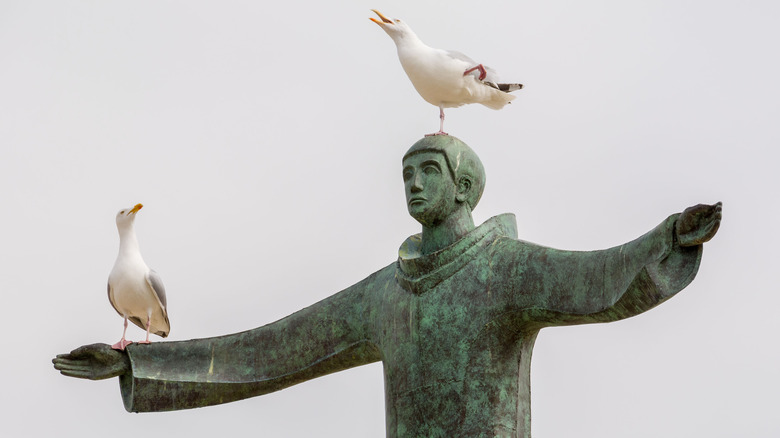
In elementary school, you probably learned that Columbus sailed the ocean blue and discovered America in 1492. Later, you learned that in fact, Norse explorers made it to America at least four centuries earlier. But what you don't learn is the possibility that someone else had already beaten the Norse to America 500 years before that.
Irish legend tells that a monk named St. Brendan the Navigator sailed west to a legendary land sometime in the 6th century AD, enduring sea monsters , volcanoes, and storms to reach a mythical, promised land that has been identified as everything from Africa to a metaphor for paradise. Among the more likely candidates, however, is North America.
St. Brendan's journey has evoked fascination among enthusiasts and scholars, who debate its veracity to this day. With a combination of archaeological evidence, modern-day attempts to recreate the voyage, and Norse stories about the Americas, the evidence suggests that St. Brendan's voyage should not be discarded. Here is the legend of the Irishman who may have "discovered" America.
Mobhi: The man who became Brendan
The man who would become St. Brendan was born in 484 AD in a place called Fenit in County Kerry, Ireland. Now, according to St. Brendan's Catholic Church , his name was originally Mobhi. But the Ireland of the 5th century AD was rapidly changing.
According to Prof. Elva Johnston of University College Dublin, late antique Ireland had seen the introduction of Christianity to the island via Roman Britain – most famously by people such as St. Patrick and St. Palladius. Obviously, the conversion of Ireland did not happen overnight, and instead, took place as a complex interplay and melding of the pagan and the Christian. Eventually, the religion reached Western Ireland where the young Mobhi lived with his family.
It is plausible to assume that Mobhi and his family were converts to Christianity from Celtic paganism, because when he was baptized by one Bishop Erc, his name was changed to Broenn-Finn, or in English parlance, Brendan. Finally, at the age of 26, he was ordained a priest. Armed with the zeal of a convert, St. Brendan threw himself into making converts among his people through an institution that would shape the Celtic Christianity of the British isles – monasteries.
Evangelizing the Emerald Isle one monastery at a time
The Romans never conquered Ireland, and as a result, the island was never urbanized as Roman Britain and Gaul were. There were no large cities, cathedrals, or any institutions that could reliably evangelize the population and educate it in the faith.
Thus, as St. John's Seminary notes, Ireland developed alternative infrastructure for effective evangelization. The answer was monasteries – religious communities where monks lived copying books, praying, fasting, doing penance, and most importantly educating their people in the Christian faith.
In 512, the newly minted Fr. Brendan threw himself into the monastery-building frenzy that engulfed 6th-century Ireland. Between 512 and 530 AD, St. Brendan founded two new monastic communities in Western Ireland – namely Ardfert and Shanakeel in County Cork, per The Catholic Encyclopedia . Eventually, his influence became so great that other communities were founded to propagate his spirituality, such as a remote community on the otherwise-uninhabited Blasket Islands off the coast of Kerry.
St. Brendan continued founding monasteries well into the latter half of the 6th century. He made several stops in Britain, including at the famous monastery of Iona. His most famous founding was the monastery of Clonfert in 557, where he is buried today. But it seems that somewhere in his life, he decided that his missionary zeal was going to take him West – far, far away from Ireland on a great voyage to an unknown land.
The great journey west begins
The newly-converted Irish were imbued with a missionary zeal to spread the gospel throughout Europe. Many Irish missionaries went East into Central Europe to evangelize the inhabitants of modern Germany. St. Brendan, however, wondered what and who lay beyond the shores of the Atlantic Ocean.
This great journey is preserved in the 9th-century Latin text called "The Voyage of St. Brendan the Abbot." The text narrates that a man named Fr. Barinthus came to St. Brendan and told him of a journey he undertook with one Mernoc and a handful of other monks to a place called the "Land of Promise of the Saints." Barinthus described this land as lush, green, and covered in fruits and flowers. After exploring the island for 15 days, the priest claimed that the party had reached a great river flowing from West to East. At that point, a "man, shining with great light," appeared to them and told the party to turn back. The land beyond the river was land "He [God] [would] grant unto His saints." Thus, the party returned to Ireland.
Intrigued by the story, St. Brendan chose 14 monks to search for this mystical land as Mernoc and Barinthus had done previously. But before leaving, three more monks requested to join despite warnings that they would all perish along the voyage – two of them painfully. The party then left Ireland in a small boat "covered in cow-hide" with only 40 days of provisions.
Snaking through the North Atlantic
"The Voyage of St. Brendan the Abbot" narrates that the party made many voyages rather than just one between a handful of places in the North Atlantic that can be reasonably identified today. Now, the first few years of the voyage were spent between three main places: the "Island of Sheep," the "Paradise of Birds," and the Monastery of St. Alibe, which according to historian Tim Severin,'s book " The Brendan Voyage ," likely corresponded to the Faroe Islands and an Irish monastic community somewhere between Ireland and the Faroes respectively. The identification of the islands with the Faroes is supported by local tradition. There exists a place called "Brandarsvik" – Brendan's Creek in English.
Eventually, the party continued north and west, reaching an island full of volcanoes (a.k.a. a mountain with "great smoke issuing from its summit"), which given the geology of the North Atlantic, could only have been Iceland. After encountering various other dangers, including sea monsters (likely whales) and a "gryphon," the monks encountered an island inhabited by a lone Irish hermit.
On this island, whose location is unclear because of the back-and-forth voyages between Iceland, the Faroe Islands, and other places in the North Atlantic, the party encountered an Irish monk who had originally lived in the "monastery of St. Patrick ," presumably a monastic community back in Ireland. He had abandoned his boat, relying on God to nourish him, but told St. Brendan that they would reach their final destination.
Eventually, St. Brendan and his party made landfall in the Land of Promise of the Saints. The Voyage of St. Brendan the Abbot only dedicates one short chapter to the place, leaving many details that enthusiasts of pre-Columbian transatlantic contact would give an arm and a leg to know.
Nevertheless, chapter 28 says only the following: The crew sailed westward and was eventually enveloped in a great darkness. After a voice told Brendan that his goal lay beyond the darkness, they proceeded until a light shone and revealed a gorgeous land in the throes of autumn. Trees were covered with fruit and the sun never set. It seemed quite fantastical.
For 40 days, the monks crisscrossed the land until, like Barinthus and Meroc, they came to a great river. Then, a "young man of resplendent features" (probably the same as Barinthus saw) appeared to them and said that Christ had wanted St. Brendan to explore "His diverse mysteries in this immense ocean." Once St. Brendan had fulfilled God's will, only then was he allowed to set foot on this promised soil. But like Barinthus and Meroc, the angel told him that his exploration was at an end. He ordered Brendan to take stones and fruits from the land and return to Ireland. The land he had found would only be settled by God's elect once "all nations [were] under [His} subjection."
Quite a journey all in all, but the account creates more questions than it answers starting with the most obvious: was any of this possible?
What does the evidence say?
Unfortunately, it is not possible to prove with current evidence whether St. Brendan really saw what "The Voyage" claimed he saw. But it is possible to extrapolate the plausibility of such a voyage from evidence gleaned from Norse sources and archaeology. First and foremost, there is the "Landnamabok" , a medieval Icelandic work known in English as the "Book of Settlement." Now, the Landnamabok claims that the Norse discovered and settled Iceland. As noted in the Icelandic Times , it was generally accepted that when the Norse arrived in Iceland, they found an island devoid of human habitation – except that the Landnamabok says that this was not the case.
In the prologue of the "Landnamabok," it reads that "before Iceland was peopled from Norway, there were in it men whom the Northmen call 'Papar.' A footnote in the text notes that "papar" means "father" in the sense of a Christian priest, no doubt related to the Latin/Italian "papa" meaning "pope." When the Norse arrived in Iceland, they found "Irish bells, books, and croziers," all signs that Iceland had hosted a population of Irish clergymen before the Norse arrived. These monks had also established themselves in the Faroes and in Orkney – right where St. Brendan landed more than once during his great voyage.
According to Dr. Kristjan Ahronson , there is now archaeological evidence in the form of cross carvings that suggests the "Landnamabok" is accurate. Thus, it seems that Irish clergy was already reaching Iceland well before the 8th century AD, suggesting that St. Brendan could definitely have gotten there in the 6th.
But was it America?
So Irish seafarers were already sailing the North Atlantic before the Norse were, but could they have reached America itself, as it seemed Barinthus, Meroc, and St. Brendan had? Again, there is no direct evidence, but it is possible to extrapolate from Norse sources whether such a journey and others like them could have happened.
Archaeologists now definitively know the Norse reached North America, establishing at least one settlement called L'Anse aux Meadows in Canada. But the "Landnamabok" mentions that the Norse were not alone in America – and it wasn't just the indigenous people they had to deal with. The Landnamabok narrates that one Ari Marsson was swept across the Atlantic to a place called "Ireland the Great." The inhabitants of this place, which was also referred to as "Whitemansland," held Ari in such high esteem that they would not let him return home. This land was located near Vinland, which is generally considered to have been someplace in North America, probably Canada.
Now, interestingly, this tale was originally told by a merchant named Hrafn, who had lived in Limerick, Ireland. He appears to originally have heard the story from local Irishmen. Now, the presence of a "Great Ireland" in America would mean that St. Brendan's voyage was at least plausible. And while it is tempting to write off the "Landnamabok" as a once-off, it is not the only possible mention of America.
The second Irish colony in America
A second potential reference to Irish in North America exists in the Eyrbyggja Saga . Here, a Norseman named Gudleif Gudlaufsson was blown off course while sailing from Ireland to Iceland. He ended up well west of Iceland – more specifically to the southwest, where he was shocked to find a colony of people who the saga claims spoke Irish. The people of this land – wherever it was – seized Gudhleif and his crew. Eventually, however, the chieftain honored Gudhleif and eventually let him return to Ireland.
So what does any of this have to do with St. Brendan? These two stories provide circumstantial evidence that St. Brendan's voyage was, on the face of things, plausible as far as the Norse texts are concerned. It is clear that regardless of whether the Irish made it to America, the Norse certainly believed they did. It also helps confirm parts of Brendan's narrative in relation to the North Atlantic.
So to recapitulate, recall how St. Brendan visited the Faroes, Iceland, and the lone hermit on some island in the Atlantic. It is known that Irish clergy settled Iceland and the Faroes, so Brendan's voyage to these areas, which forms the bulk of "The Voyage of St. Brendan the Abbot," is likely to be true. Then there is the question of the lone hermit. Is it possible that these monks pushed even further West and established communities that have been lost to time in the Western Hemisphere? Given the Norse evidence, it certainly seems plausible. But could these small Irish oxhide boats make it that far?
Tim Severin's voyage
So far, the evidence shows that St. Brendan's voyages were not out of the ordinary in his time. But was a transatlantic voyage to America in a small oxhide boat possible? In 1976, sailor and historian Timothy Severin proved that it indeed was. In his book titled "The Brendan Voyage," Severin recounted how he got together a crew and built a boat called a currach (illustrated above), similar to St. Brendan's vessel. Severin's crew retraced St. Brendan's voyage to the best of their ability, sailing from Ireland up to the Faroe Islands. From there, they went to Iceland, down the coast of Greenland , and eventually reached Newfoundland. The boat that people had written off as a rickety deathtrap was actually quite sturdy.
Now, Severin did not prove that St. Brendan made the trip – he only proved it was possible. But he noted in his book that his experiences and observations were similar to St. Brendan's, especially when stripping away mythological aspects. Thus, sea monsters and giant friendly fish made sense when Severin and his crew saw whales come up to play near their boat. The mountains of fire were Icelandic volcanoes. The "pillars of crystal" were likely icebergs.
And what about America? All Severin had to say was that St. Brendan's description of his promised land bore a close resemblance to the northeastern part of America – that is New England and Eastern Canada. Again, there was no way to tell for sure, but despite all the fantastical details, "The Voyage of St. Brendan the Abbot" suddenly made sense.
Making sense of it all
So all in all, how does one make sense of these facts? The reality is that all that is available as evidence are Norse sources, Irish legends and traditions, and the heavily mythologized narrative of St. Brendan's voyage. If the story is true, it would be the oldest documented transatlantic crossing — the second oldest if the story of Meroc that inspired St. Brendan is taken seriously.
Now, the reality is that there is no definitive evidence on the ground that scholars agree upon. Some enthusiasts, including former Harvard professor Barry Fell, as recorded in the Los Angeles Times , have cited a number of carvings as evidence for Irish presence in America, arguing that these carvings represent an Old Irish alphabet called Ogam. Most scholars, on the other hand, discount these theories. Apart from this, there are disparate native traditions such as an alleged Shawnee legend recorded by Danish scholar Carl Rafn, which told of Europeans living in the southeastern United States.
So as it appears, the debate is unlikely to end anytime soon — at least not until some definitive Irish artifact from pre-Colombian America appears. But the legends should not be discounted, either. There is too much Norse evidence for that. But if they are true, it means that Columbus was just following the well-worn path of legendary Irish monks who risked everything to go out and preach the Gospel to all the nations of the world.
We will keep fighting for all libraries - stand with us!
Internet Archive Audio

- This Just In
- Grateful Dead
- Old Time Radio
- 78 RPMs and Cylinder Recordings
- Audio Books & Poetry
- Computers, Technology and Science
- Music, Arts & Culture
- News & Public Affairs
- Spirituality & Religion
- Radio News Archive

- Flickr Commons
- Occupy Wall Street Flickr
- NASA Images
- Solar System Collection
- Ames Research Center

- All Software
- Old School Emulation
- MS-DOS Games
- Historical Software
- Classic PC Games
- Software Library
- Kodi Archive and Support File
- Vintage Software
- CD-ROM Software
- CD-ROM Software Library
- Software Sites
- Tucows Software Library
- Shareware CD-ROMs
- Software Capsules Compilation
- CD-ROM Images
- ZX Spectrum
- DOOM Level CD

- Smithsonian Libraries
- FEDLINK (US)
- Lincoln Collection
- American Libraries
- Canadian Libraries
- Universal Library
- Project Gutenberg
- Children's Library
- Biodiversity Heritage Library
- Books by Language
- Additional Collections

- Prelinger Archives
- Democracy Now!
- Occupy Wall Street
- TV NSA Clip Library
- Animation & Cartoons
- Arts & Music
- Computers & Technology
- Cultural & Academic Films
- Ephemeral Films
- Sports Videos
- Videogame Videos
- Youth Media
Search the history of over 866 billion web pages on the Internet.
Mobile Apps
- Wayback Machine (iOS)
- Wayback Machine (Android)
Browser Extensions
Archive-it subscription.
- Explore the Collections
- Build Collections
Save Page Now
Capture a web page as it appears now for use as a trusted citation in the future.
Please enter a valid web address
- Donate Donate icon An illustration of a heart shape
A journey from St. Petersburg to Moscow.
Bookreader item preview, share or embed this item, flag this item for.
- Graphic Violence
- Explicit Sexual Content
- Hate Speech
- Misinformation/Disinformation
- Marketing/Phishing/Advertising
- Misleading/Inaccurate/Missing Metadata
![[WorldCat (this item)] [WorldCat (this item)]](https://archive.org/images/worldcat-small.png)
plus-circle Add Review comment Reviews
1,143 Views
10 Favorites
DOWNLOAD OPTIONS
No suitable files to display here.
IN COLLECTIONS
Uploaded by station21.cebu on February 14, 2019
SIMILAR ITEMS (based on metadata)

As Ukraine Rebuilds Its Identity, Folk Songs Are the New Cool
Faced with Russia’s efforts to erase Ukrainian culture, people have embraced traditional music as a way to reconnect with their past and affirm their identity.
Roksolaniya, a traditional Ukrainian singing group, performs during Orthodox Easter festivities at the St. Sophia Cathedral complex in Kyiv last month. Credit...
Supported by
- Share full article
By Constant Méheut and Daria Mitiuk
Photographs and Video by Brendan Hoffman
Reporting from Kyiv, Ukraine
- June 5, 2024
At first sight, it looked like a typical party in a nightclub. It was mid-March in central Kyiv and a hundred or so people were wiggling on the dance floor of V’YAVA, one of the Ukrainian capital’s most popular live music venues. The hall was dark, lit only by bright blue and red spotlights. Bartenders were busy pouring gin and tonics.
But the lineup that night, in a concert hall that typically hosts pop artists and rappers, was unexpected: four Ukrainian folk singers, filling the room with their high-pitched voices and polyphonic choruses, accompanied by a D.J. spinning techno beats — all to a cheering crowd.
These days, Ukrainian folk music “is becoming something cool,” said Stepan Andrushchenko, one of the singers from Shchuka Ryba , the band onstage that night. “A very cool thing.”
More than two years into Russia’s full-scale invasion of Ukraine, folk music is enjoying a surge of popularity in the war-torn nation. Faced with Moscow’s efforts to erase Ukrainian culture , people have embraced traditional songs as a way to reconnect with their past and affirm their identity.
“It’s like a defensive measure,” said Viktor Perfetsky, 22, who started traditional singing classes after the war broke out. “If we don’t know who we are, the Russians will come and force us to be what they want us to be.”

That is a stark change of attitude in Ukraine, where folk songs had long been dismissed as archaic relics of peasant culture. Today, those same songs are being played at open-air festivals and in trendy bars. Classes in “white voice” singing, a traditional Ukrainian vocal style akin to controlled yelling, are selling out, and youngsters practice traditional dances in the streets of Kyiv, with cans of beer in their hands.
Bands like Shchuka Ryba are building on that trend to bring folk songs into the 21st century. They have collaborated with D.J.s and jazz bands to give the music a modern twist, adding electronic overtones and guitar melodies. Their ultimate goal: to reshape Ukraine’s identity around its rich but long-ignored past.
“It shouldn’t be a passing trend,” Yarina Sizyk, 27, a Shchuka Ryba singer with a distinctive, strident voice, said in a recent interview. “It should be part of everyday life.”
Folk music has been hummed in Ukraine for centuries, but they were long stereotyped as backward. In Soviet times, some folk songs were taught in schools, performed by ensembles and generally used for propaganda, but the authorities ended up turning them into a poor imitation of folk peasant culture, experts say.

After Ukraine gained independence in 1991, some groups traveled across the country to try and salvage that heritage. Kateryna Kapra, a co-founder of the cultural organization Rys, said she toured villages in central and eastern Ukraine in the mid-2010s to record and preserve authentic folk songs.
But back in Kyiv, Kapra struggled to elicit interest from urban residents. She recalled trying to organize workshops to teach traditional carols: “It was so difficult to find just 10 people in such a big city.”
Many Ukrainians were skeptical of folk music, fearing that it played into “Kremlin stereotypes about how Ukrainians are just singing peasants,” said Maria Sonevytsky, a Ukrainian American ethnomusicologist and the author of “ Wild Music: Sound and Sovereignty in Ukraine .”
All that changed after Russia invaded on Feb. 24, 2022. As Moscow targeted Ukraine’s cultural heritage, including by bombing and looting museums, the songs became a marker of the Ukrainian identity.
“People realized that it’s more important than ever to preserve this culture, because it could be destroyed at any moment,” said Andrii Solomiichuk, 33, who was listening to a folk music performance in the gardens of Kyiv’s Cathedral of Saint Sophia on a recent Sunday afternoon.

Around him, small groups of folk singers dressed in traditional embroidered shirts were seated on the grass, rehearsing as they readied to take the stage. Many in the audience said they had started to listen to folk music only after the war began, drawn by a desire to reclaim their roots. “Traditions are the foundation, the lifeblood of the nation,” said Iryna Bilonizhka, 34.
As the war drags on, singing classes run by Rys have filled up. Kapra said tickets for a summer school last year “sold out in a day.”
At a recent class in Kyiv, six men stood in a semicircle and puffed out their chests as they ran through some vocal exercises. “Ta-te-ti-to-tu-to-ti-te-ta,” they sang, rising a note with each repetition and filling the room with their deep voices.
It felt like an oasis of peace in the middle of the war-battered city, but signs of the fighting were not far away. One student had a prosthetic leg — it was amputated after stepping on a mine at the front last year — while another wore a T-shirt evoking Ukrainian airstrikes on Russian targets.
Stanislav Ivko, the student who lost his leg, said he enjoyed learning about Ukraine’s history through the songs. One of his favorite ballads, “ Hey, I Had a Horse ,” recounts the hardships of the Cossacks, horsemen who once ruled over Ukraine’s southern regions, and their longing for better times.
Sonevytsky, the ethnomusicologist, said the songs were “a way of showing a kind of historical presence” for Ukraine and a means of countering the Kremlin’s claim that Ukraine’s nationhood is a fiction by recovering “something that was lost during the Soviet period.”
That return to the roots, however, doesn’t preclude a modern touch.

After the war began, the band Shchuka Ryba started collaborating with Fusion Jams , a Kyiv-based community of musicians, to blend traditional tunes with elements of more mainstream music like jazz, rock and electro. Their goal was spreading folk songs as widely as possible.
“We’re trying to make them accessible to a young audience,” Sizyk said on a recent afternoon. “It’s not just for grandmas and grandpas.”
She and other Shchuka Ryba members had just finished rehearsing their most popular track, “ Oh, My Father Had a Daughter ,” with a bassist, drummer and pianist in a studio in central Kyiv. The track is based on a folk song recorded several years ago among villagers in central Ukraine, to which the band added drums and synths.
Andrushchenko said the band wanted folk music to “become a part of someone’s life” so it has “a deeper sense than just trends.” Its members make a point, for example, of teaching spectators about traditional dances during their concerts — pausing the music to arrange them in rows and showing them the basics.
This has led to some unusual scenes in some of the Ukrainian capital’s trendiest venues. At the V’YAVA concert hall in mid-March, the band led the crowd into a kind of circle dance, with people holding hands as they spun around the room, as the bartenders looked on, surprised.
Perfetsky, who joined singing classes at the start of the war and now runs his own weekly singing sessions in a cafe, said Shchuka Ryba had inspired many to embrace folk music. “People now think, ‘Wow, they’re so cool,” he said. “And people are like, ‘I want to sing too!’”
Constant Méheut reports on the war in Ukraine, including battlefield developments, attacks on civilian centers and how the war is affecting its people. More about Constant Méheut
Advertisement
- Biography & Photos
- Teaching-Workshops
- Disclosure & Ads
- News Releases
- Submissions
- Contact Maralyn
Select Page
“Beyond the Expected” – Moscow & St. Petersburg by Brendan Vacations
Posted by Maralyn D. Hill | Lifestyle Press Releases |
Beyond the Expected: Moscow & St. Petersburg ~ Part Three in Brendan’s “New Discoveries with Gems of Northeastern Europe” ~
- Print Friendly
- StumbleUpon
Maralyn D. Hill , The Epicurean Explorer
President, International Food Wine & Travel Writers Association
Editor-at-Large, CityRoom
Blogs: Where and What in the World & Success with Writing
https://authorcentral.amazon. com
About The Author
Maralyn D. Hill
Born to travel and tell the tale. President Emeritus of the international Food Wine & Travel Writers Association, member of Society of American Travel Writers Association, and the Society of Professional Journalists, Known as The Epicurean Explorer, I am a freelance writer with several outlets and have three blogs http://WhereAndWhatInTheWorld.com, http://SuccessWithWriting.com, www.TheEpicureanExplorer.com. Executive Editor of Luxe Beat Magazine, http://www.luxebeatmag.com
Related Posts
News: holland america line’s ms eurodam achieves seventh consecutive perfect score of 100 on united states public health inspection.
November 17, 2014
Planned Parenthood’s 2015 Food Fare Calendar Announcement
November 21, 2014
Helsinki Airport determined to remain an attractive international hub: services will expand under one roof
October 13, 2014
Verde Valley & Wine Trail named in Lonely Planet’s TOP 10
December 7, 2012
Good blog post. I certainly love this website. Thanks!
Thanks Shonda for commenting. I’m glad you enjoy our site. ~MDH
Leave a reply Cancel reply
Your email address will not be published. Required fields are marked *
This site uses Akismet to reduce spam. Learn how your comment data is processed .
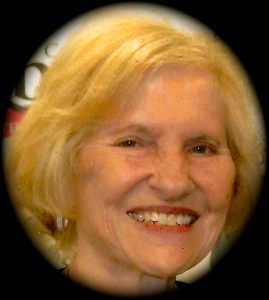
Follow Maralyn
Recent posts.
- Norwegian Cruise Line Announces Encore Moments Campaign Winners
- Luxury Rollerball Pen as a Work of Art
- The Bodrum EDITION Wellness Weekend
- AZ Youth Climate Strike September 20th
Pin It on Pinterest
Washington Post hardcover bestsellers
A snapshot of popular books.

1 FUNNY STORY (Berkley, $29). By Emily Henry. Daphne, whose ex-fiancé, Peter, left her for another woman, agrees to be roommates with Miles, whose ex-fiancée left him for Peter.
2 THE WOMEN (St. Martin’s, $30). By Kristin Hannah. An Army nurse in Vietnam treats soldiers wounded in combat but struggles to find support when she returns home.
3 JAMES (Doubleday, $28). By Percival Everett. A reimagining of “Adventures of Huckleberry Finn” told from the point of view of Jim as he flees from enslavement.
4 YOU LIKE IT DARKER (Scribner, $30). By Stephen King. Stories, many never before published, centered on the darker side of life.
5 ALL FOURS (Riverhead, $29). By Miranda July. A woman embarks on a solo cross-country road trip but instead hides in a nearby hotel and explores life without the responsibilities of family.
6 THE MINISTRY OF TIME (Avid Reader, $28.99). By Kaliane Bradley. A top-secret British government assignment requires a woman to guide a Victorian-era explorer who has recently been returned to life in the modern age.
7 CAMINO GHOSTS (Doubleday, $29.95). By John Grisham. The last inhabitant of an island stands in the way of a resort developer who is trying to claim ownership.
8 TABLE FOR TWO (Viking, $32). By Amor Towles. A collection of stories plus one historical novella from the author of “A Gentleman in Moscow.”
9 LONG ISLAND (Scribner, $28). By Colm Tóibín. In a sequel to “Brooklyn,” the now middle-aged Eilis Lacey visits her mother in Ireland during a profound personal crisis.
10 THE PARIS NOVEL (Random House, $29). By Ruth Reichl. The award-winning food writer’s novel follows a woman who discovers her passions in 1980s Paris.
1 THE DEMON OF UNREST (Crown, $35). By Erik Larson. The author of “The Splendid and the Vile” chronicles the months after Abraham Lincoln’s election that set the stage for the Civil War.
2 THE ANXIOUS GENERATION (Penguin Press, $30). By Jonathan Haidt. A social psychologist attributes the recent increase in adolescent mental illness to the prevalence of smartphones.
3 THE CREATIVE ACT (Penguin, $32). By Rick Rubin. A Grammy-winning music producer shares how artists work and suggests ways to foster creativity in everyday life.
4 AN UNFINISHED LOVE STORY (Simon & Schuster, $35). By Doris Kearns Goodwin. The Pulitzer Prize-winning biographer shares her own history.
5 A WALK IN THE PARK (Scribner, $32.50). By Kevin Fedarko. Two men attempt a 750-mile hike through the Grand Canyon.
6 IN MY TIME OF DYING (Simon & Schuster, $27.99). By Sebastian Junger. The war reporter and avowed atheist considers mortality and the afterlife following his near-death experience.
7 THE WAGER (Doubleday, $30). By David Grann. After enduring storms, sickness and a shipwreck, the surviving crew members of HMS Wager turn against each other.
8 REBEL GIRL (Ecco, $29.99). By Kathleen Hanna. The Bikini Kill frontwoman recalls the dark side of the music scene.
9 THE WIDE WIDE SEA (Doubleday, $35). By Hampton Sides. An account of the explorer Captain James Cook’s ill-fated final voyage.
10 SOMEHOW (Riverhead, $22). By Anne Lamott. An exploration of the power of different types of love.
Rankings reflect sales for the week ended June 2. The charts may not be reproduced without permission from the American Booksellers Association, the trade association for independent bookstores in the United States, and indiebound.org . Copyright 2024 American Booksellers Association. (The bestseller lists alternate between hardcover and paperback each week.)
We are a participant in the Amazon Services LLC Associates Program, an affiliate advertising program designed to provide a means for us to earn fees by linking to Amazon.com and affiliated sites.


IMAGES
VIDEO
COMMENTS
The Voyage of Saint Brendan by Edward Reginald Frampton, 1908. Belfast poet Pádraic Fiacc wrote the poem LEGEND, where he suggests the great Irish evangelist St Brendan, met peacefully with the American Native Indian peoples - a different proposition to the later colonists who arrived from Europe searching for wealth.
"St. Brendan's Voyage" is a modern Irish folk song, written by Christy Moore, and released on his 1985 album Ordinary Man. The song relates the legendary journey of Saint Brendan in a comic and fanciful way. The Narrative. The body of the song consists of four eight-line verses, each followed by a four-line chorus.
Saint Brendan (also referred to by his various epithets 'the Navigator', 'the Voyager', 'the Anchorite', and 'the Bold') was an Irish saint who lived between the 5th and 6th centuries AD known for his legendary voyage in search of the 'Island of Paradise' or the 'Land of Promise of the Saints'.
published on 06 February 2019. Subscribe to topic. Between the 9th and the 10th century CE, in an unknown European abbey, an anonymous author told the story of an Irish monk and his 14 companions who embarked on a dangerous journey in the 5th century CE. The monk's name was Brendan, and his destination was the Terra repromissionis sanctorum ...
The climax of St. Brendan's voyage was the discovery of the Land of Promise. This land, as described in the Navigatio, was a paradise filled with lush vegetation, abundant flowers, and rich fruits. After spending forty days exploring this land, an angel appeared to Brendan and told him to return to Ireland. The angel informed Brendan that the ...
By Andrea Maraschi. Between the ninth and the tenth century, in an unknown European abbey, an anonymous author told the story of an Irish monk and his fourteen companions who embarked on a dangerous journey in the fifth century. The monk's name was Brendan, and his destination was the Terra repromissionis sanctorum, the Promised Land of the ...
St. Brendan (born c. 484/486, Tralee, now in County Kerry, Ireland—died 578, Annaghdown, County Galway; feast day May 16) was a Celtic saint, monastic founder, abbot, and hero of legendary voyages in the Atlantic Ocean. Reputedly raised and educated by Abbess St. Ita at her boys' school in what later became County Limerick, he later studied ...
Sorry bout dis lads
St. Brendan's Voyage. Christy Moore. A boat sailed out of Brandon in the year of 501. 'twas a damp and dirty mornin' Brendan's voyage it began. Tired of thinnin' turnips and cuttin' curley kale. When he got back from the creamery he hoisted up the sail. He ploughed a lonely furrow to the north, south, east and west.
In conclusion, "St. Brendan's Voyage" by Christy Moore is a charming and uplifting song that tells the tale of St. Brendan's adventurous journey. The lyrics, infused with Irish wit and humor, take us on a voyage with the saint as he navigates the seas and faces the challenges of life. Through this song, we are reminded of the resilient ...
St. Brendan's Voyage Lyrics. A boat sailed out of Brandon in the year of 501. 'twas a damp and dirty mornin' Brendan's voyage it began. Tired of thinnin' turnips and cuttin' curley kale. When he ...
In the 6th-century, an Irish monk named St. Brendan wrote the Navigatio Sancti Brendani Abbatis (The Voyage of St. Brendan the Abbot), a document describing a westward sea journey to the "promised land" that some believe was North America. The journey included numerous stops at islands along the way, and he described seeing fantastic sights ...
Includes the Catholic Encyclopedia, Church Fathers, Summa, Bible and more — all for only $19.99... St. Brendan of Ardfert and Clonfert, known also as Brendan the Voyager, was born in Ciarraighe Luachra, near the present city of Tralee, County Kerry, Ireland, in 484; he died at Enachduin, now Annaghdown, in 577.
The Voyage of Saint Brendan the Abbot is one example of an entire genre of Celtic literature, the immram—a class of Christian legends concerning a hero's voyage west across the sea to an Eden-like paradise, a land of perpetual youth, abundance, and happiness. These stories may have been attempts to Christianize the pagan traditions of the ...
If right were right the United States of America would be known as the United States of Brendan, given that Brendan The Navigator - St Brendan - was the firs...
St Brendan's Legacy. Saint Brendan is featured as well known inspiration in popular culture also, such as; "The Brendan Voyage", which is an orchestral suite for the Uilleann pipes, written by Irish composer Shaun Davey in 1983 and based on Tim Severin's book of the same name.
Tim Severin's book The Brendan Voyage is one of those sources. Tim Severin (1940-2020). Photograph from www.timseverin.net. ... Saint Brendan had made the journey in a large currach made of a wooden frame and covered with tanned oxhides. Severin's aim was to see whether Saint Brendan's journey had been possible and to do that the group ...
St. Brendan's journey has evoked fascination among enthusiasts and scholars, who debate its veracity to this day. With a combination of archaeological evidence, modern-day attempts to recreate the voyage, and Norse stories about the Americas, the evidence suggests that St. Brendan's voyage should not be discarded.
The Brendan Voyage was Shaun Davey's first major orchestral suite, composed for uilleann pipes played by Liam O'Flynn.It depicts Tim Severin's adventure in reconstructing Saint Brendan's 6th century Atlantic crossing to America. It features guest musicians Paul MacAteer (drums), Garvan Gallagher (electric bass) and Tommy Hayes (bodhran). The album title is also the title of Severin's book ...
Brendan (the Navigator) of Clonfert ca. 484-557; Clement of Alexandria ca. 150-215; Pope St. Clement of Rome fl. ca. 80-102; ... St. Tikhon of Moscow 1865-1925. Beloved in Christ, fathers and brethren, I have just uttered the prescribed words: "I thank and accept and say nothing against." Of course, enormous is my gratitude to the Lord for ...
A journey from St. Petersburg to Moscow. by Radishchev, Aleksandr Nikolaevich, 1749-1802. Publication date 1958 Topics Serfdom -- Soviet Union, Soviet Union -- Description and travel, Soviet Union -- Social conditions Publisher Cambridge : Harvard University Press Collection internetarchivebooks; printdisabled Contributor Internet Archive
Today we commemorate the great saint of Moscow, Metropolitan Philaret (Drozdov) of Moscow and Kolomna. St. Philaret was born in 1782 in the suburban town of Kolomna, east of Moscow, to a clergyman's family. He studied at the local seminary, but his intellectual and literary talents were extraordinary, and in 1817 he was consecrated a bishop.
Brendan Hoffman for The New York Times. The group aims to give the music a modern twist. Their ultimate goal: reshaping Ukraine's identity around its rich but long-ignored past. Andrushchenko ...
Facebook Twitter Google+ Digg Pinterest Print Friendly reddit LinkedIn StumbleUpon Tumblr FOR IMMEDIATE RELEASE June 2012 www.brendanvacations.com FOR MORE INFORMATION Contact: Arnelle Kendall Telephone: (561) 330-0850 E-mail: [email protected] Beyond the Expected: Moscow & St. Petersburg ~ Part Three in Brendan's "New Discoveries with Gems of Northeastern Europe" ~ Brendan ...
1 FUNNY STORY (Berkley, $29). By Emily Henry. Daphne, whose ex-fiancé, Peter, left her for another woman, agrees to be roommates with Miles, whose ex-fiancée left him for Peter. 2 THE WOMEN (St ...